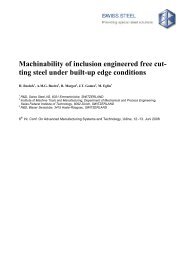Application of Thermodynamic Model for Inclusion Control in ...
Application of Thermodynamic Model for Inclusion Control in ...
Application of Thermodynamic Model for Inclusion Control in ...
Create successful ePaper yourself
Turn your PDF publications into a flip-book with our unique Google optimized e-Paper software.
Process Metallurgy – Steelmak<strong>in</strong>g<br />
The model has been validated <strong>in</strong> <strong>of</strong>f-l<strong>in</strong>e applications by<br />
previous <strong>in</strong>dustrial studies on slag-melt equilibration, exogenous<br />
oxide <strong>in</strong>clusion and <strong>in</strong>digenous oxide <strong>in</strong>clusions<br />
[8]. In the present <strong>in</strong>vestigation the model was used <strong>for</strong> deoxidation<br />
control <strong>of</strong> the melt <strong>in</strong> the LMF station <strong>of</strong> the von<br />
Moos Stahl steel shop. In silicon deoxidation <strong>for</strong> LCFCS,<br />
the result<strong>in</strong>g oxygen activity now could either be calculated<br />
by the model assum<strong>in</strong>g slag metal equilibrium at 1600°C or<br />
measured by us<strong>in</strong>g CELOX probes. Figure 5 shows the<br />
very first results <strong>of</strong> four heats differ<strong>in</strong>g slightly <strong>in</strong> chemical<br />
composition <strong>of</strong> the melt and <strong>of</strong> the LMF slag. The circles<br />
represent the measured data which fall on the curves predicted<br />
by the model. The close agreement between the model<br />
prediction and the actual measurement serves as validation<br />
<strong>of</strong> the model. It can be seen that the effect <strong>of</strong> <strong>in</strong>creas<strong>in</strong>g<br />
silicon content is to decrease the oxygen activity <strong>in</strong> the<br />
melt, which saturates out at large silicon content. However,<br />
deoxidation potential <strong>of</strong> silicon <strong>in</strong>creases with change <strong>of</strong><br />
slag composition. Decreas<strong>in</strong>g the silica activity <strong>of</strong> slag decreases<br />
the soluble oxygen content <strong>in</strong> the melt <strong>for</strong> a given<br />
silicon content <strong>in</strong> accordance with model predictions.<br />
<strong>Inclusion</strong> eng<strong>in</strong>eer<strong>in</strong>g <strong>of</strong> steel grade 11SMn37<br />
The production l<strong>in</strong>e <strong>of</strong> the steel shop at von Moos Stahl<br />
AG is shown schematically <strong>in</strong> Figure 6. In the electric arc<br />
furnace (EAF) the scrap is melted and subsequently tapped<br />
<strong>in</strong>to the ladle. At this moment primary deoxidation processes<br />
are started. Synthetic slag addition, the carry- over slag<br />
from EAF and deoxidation products determ<strong>in</strong>e the slag<br />
composition which has to be controlled with<strong>in</strong> narrow tolerances.<br />
At the ladle metal furnace (LMF) small slag corrections<br />
can still be done. Slag-metal equilibration is used<br />
to control the residual concentration <strong>of</strong> reactive elements<br />
Figure 5. Comparison <strong>of</strong> the oxygen activities measured <strong>in</strong> the melt<br />
and the data calculated by the model under the slag-melt equilibration<br />
<strong>in</strong> LMF at 1600 o C.<br />
Figure 6. Schematic diagram <strong>of</strong> production l<strong>in</strong>e <strong>of</strong> the steel shop at<br />
von Moos Stahl AG.<br />
and soluble oxygen <strong>in</strong> the melt. Exist<strong>in</strong>g exogenous <strong>in</strong>clusions<br />
are modified by Ca treatment. After LMF treatment at<br />
1600°C still 25 – 50 ppm oxygen are dissolved <strong>in</strong> the melt.<br />
<strong>Control</strong>led by the chemical composition <strong>of</strong> the melt, the<br />
oxygen <strong>for</strong>ms <strong>in</strong>digenous <strong>in</strong>clusions dur<strong>in</strong>g solidification at<br />
the cont<strong>in</strong>uous caster. In the standard 11SMn37 grade these<br />
<strong>in</strong>clusions are rich either <strong>in</strong> Al2O3 or MnO depend<strong>in</strong>g on the<br />
Al level <strong>in</strong> the steel and <strong>in</strong> all cases they are crystall<strong>in</strong>e. To<br />
get the beneficial glassy <strong>in</strong>clusions the silicon content <strong>of</strong> the<br />
steel must be about 0.2 % and the target ratio <strong>of</strong> CaO/SiO2<br />
<strong>in</strong> the LMF slag is close to unity.<br />
The thermodynamic modell<strong>in</strong>g is applied onl<strong>in</strong>e to predict<br />
the compositions <strong>of</strong> exogenous and <strong>in</strong>digenous <strong>in</strong>clusions.<br />
This allows <strong>for</strong> the course correction to achieve the<br />
target slag at the LMF station and guarantees a stable<br />
process. The three important steps <strong>in</strong> <strong>in</strong>clusion eng<strong>in</strong>eer<strong>in</strong>g<br />
<strong>of</strong> steel <strong>for</strong> produc<strong>in</strong>g glassy oxide <strong>in</strong>clusions are shown <strong>in</strong><br />
Figure 7. Step-1 is the design <strong>of</strong> LMF slag to control residual<br />
alum<strong>in</strong>ium and residual oxygen contents <strong>in</strong> the melt<br />
through slag-melt <strong>in</strong>teraction (suppos<strong>in</strong>g slag-melt equilibrium).<br />
The thermodynamic modell<strong>in</strong>g gives the required<br />
slag composition. Step-2 is the design <strong>of</strong> deoxidation<br />
processes at the LMF to produce the target glassy exogenous<br />
oxide <strong>in</strong>clusions. A calcium treatment is used to modify<br />
exist<strong>in</strong>g oxide <strong>in</strong>clusions <strong>in</strong> LMF. The expected <strong>in</strong>clusions<br />
are predicted by the model. Step-3 is the design <strong>of</strong> deoxidation<br />
dur<strong>in</strong>g solidification to <strong>for</strong>m the optimum target<br />
<strong>in</strong>digenous glassy oxide <strong>in</strong>clusions. The model calculates<br />
the <strong>in</strong>clusion composition <strong>for</strong> a given melt chemistry.<br />
Results<br />
Four 80 ton heats <strong>of</strong> an <strong>in</strong>clusion eng<strong>in</strong>eered 11SMn37<br />
were produced by cast<strong>in</strong>g 135 x 135 mm 2 billets and subsequent<br />
roll<strong>in</strong>g to wire rods <strong>of</strong> 33 and 37 mm diameter. At<br />
Steeltec, a sister company <strong>of</strong> von Moos Stahl, the wire rods<br />
were cold drawn to 31 and 35 mm bright bars respectively.<br />
<strong>Inclusion</strong> characterization. To verify the <strong>in</strong>clusion composition<br />
SEM/EDX techniques were applied on one <strong>in</strong>clusion<br />
eng<strong>in</strong>eered heat us<strong>in</strong>g the PSEM <strong>of</strong> the company RJL<br />
Micro & Analytic[12]. By this method a 150.87 mm 2 area<br />
section was scanned with a 0.895 µm grid size. The morphology<br />
and the chemical composition <strong>of</strong> every registered<br />
318 steel research <strong>in</strong>t. 75 (2004) No. 5










